A subscription to JoVE is required to view this content. Sign in or start your free trial.
Methods Article
Continuous In-woods Production of Biochar Using a Trailer-Mounted Air Curtain Burner
In This Article
Summary
We describe the use of a place-based mobile pyrolysis unit equipped with an air curtain to continuously create biochar. The technology reduces the need for open slash pile burning, which results in lower emissions and fewer soil impacts. The protocol includes guidelines for site selection, loading, and quenching.
Abstract
Fuel treatments and other forest restoration thinning practices aim to reduce wildfire risk while building forest resilience to drought, insects, and diseases and increasing aboveground carbon (C) sequestration. However, fuel treatments generate large amounts of unmerchantable woody biomass residues that are often burned in open piles, releasing significant quantities of greenhouse gases and particulates, and potentially damaging the soil beneath the pile. Air curtain burners offer a solution to mitigate these issues, helping to reduce smoke and particulates from burning operations, more fully burn biomass residues compared to pile burning, and eliminate the direct and intense fire contact that can harm soil beneath the slash pile. In an air curtain burner, burning takes place in a controlled environment. Smoke is contained and recirculated by the air curtain, and therefore burning can be conducted under a variety of climatic conditions (e.g., wind, rain, snow), lengthening the burning season for disposal of slash material. The mobile pyrolysis unit that continuously creates biochar was specifically designed to dispose of residual woody biomass at log landings, green wood at landfills, or salvaged logged materials and create biochar in the process. This high-carbon biochar output can be used to enhance soil resilience by improving its chemical, physical, and biological properties and has potential applications in remediating contaminated soils, including those at abandoned mine sites. Here, we describe the general use of this equipment, appropriate siting, loading methods, quenching requirements, and lessons learned about operating this new technology.
Introduction
Across the U.S.A., many forest stands have increased in standing tree volume in the absence of frequent low-intensity fires, historically set by indigenous people and suppressed in modern times1,2. From this fire exclusion, the resulting overstocked stands pose challenges for land managers striving to enhance forest resilience against wildfires, pests, diseases, and drought effects3. Standard management practices for reducing tree volume include prescribed fire, pre-commercial thinning, and mature stand harvesting. These operations generate substantial amounts of low- and no-value woody biomass, often called residues. For example, in the 15 states of the western U.S.A., it is estimated that harvest operations produce nearly 8 million dry tons of residues each year4. Further, the USDA Forest Service has implemented a wildfire crisis plan, which will treat an additional 50 million acres (20 million hectares) over a 10-year period. This will result in the need to dispose of additional unmerchantable material and likely require the use of a variety of place-based options. Although tops, limbs, and unmerchantable trees can be used for bioenergy or biofuels, limited market opportunities often lead to these residues being piled and burned. Building slash piles aims to reduce wildfire and insect risk, create growing space for understory plants, and address other land management objectives.
Open pile burning is a low cost, relatively fast method for reducing wood volume, but it also produces smoke and air pollutants, including greenhouse gases5. Further, it may also cause undesirable impacts on soil physical, chemical, and biological properties, leading to burn scars that can persist for decades6. To mitigate the detrimental side effects of open burning, alternative approaches are needed that reduce negative impacts on climate change, wildfire risk, and soil health7.
Here, we focus on the use of a novel method for continuous biochar production developed through a Cooperative Research and Development Agreement (CRADA) between the U.S. Department of Agriculture, Forest Service, Rocky Mountain Research Station, and Air Burners, Inc. (Palm City, FL). The resulting technology, henceforth referred to as the biochar-producing air curtain burner (BACB; Figure 1), continuously produces biochar from woody residues while limiting smoke and particulate emissions. Compared with open burning, the functionality of the BACB reduces fire risk and the spread of smoke8, creating avenues for the safe extension of operational burn windows. Unlike traditional methods that leave residue piles on the landscape where they contribute to fuel accumulations9 or alternative combustion methods that primarily produce smoke and ash, the BACB effectively reduces fuel loads while protecting the soil and creating biochar, a consistent, high carbon charcoal, that can be used for soil restorations' on or near the site of processing. Further, the BACB is mobile and can easily be sited, for example, at a log landing, along a roadside, or in a campground. It can also burn wet or dry wood, mixed feedstock types, and sizes, and can be used in inclement weather and at times when weather conditions are too risky for open pile burning.
Biochar produced in the BACB is generally 70%-90% carbon, highly porous, and consistent in particle size distribution, making it suitable for remediating degraded soils, often found at abandoned mines, log landings, skid trails, riparian areas, or agricultural sites. Biochar can also be used as a mix with compost or in livestock feedlots to adsorb nutrients and reduce odor. In general, the best soil uses for woody residue biochar are to reduce erosion and nitrate leaching while enhancing soil aggregate stability and available water in coarse-textured, low organic matter soils10,11.
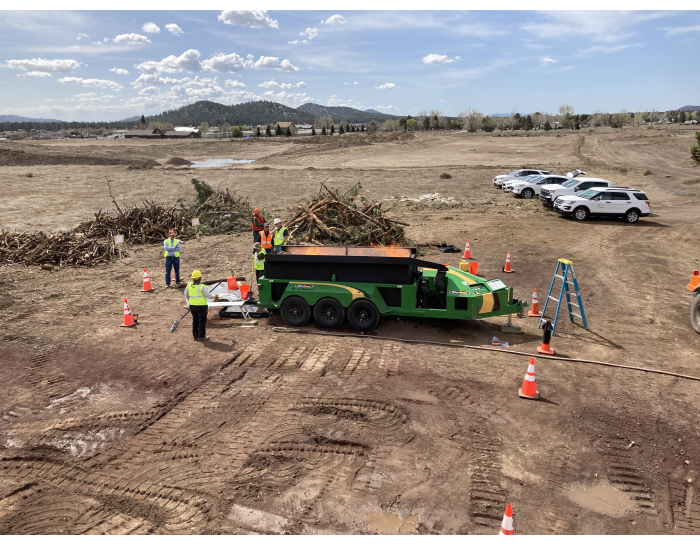
Figure 1: Mobile biochar-producing air curtain burner. The test site shows the general configuration of the slash and the biochar-producing air curtain burner. This figure has been modified from12. Please click here to view a larger version of this figure.
Overview of design and operation
Although there are several types of air curtain burners available, the BACB continuously creates biochar. The unit is approximately 7 m long x 2.5 m wide x 2 m high. It has an air manifold along the top of the firebox that provides a steady curtain of air to contain smoke, particulates, and embers within it and promotes complete oxidation of emissions. For optimal operation, the firebox is loaded to a level just below the manifold, ensuring uninterrupted airflow across the firebox. The BACB can be towed behind any vehicle with a standard hitch package and adequate towing capacity. A level, smooth site is prepared close to the piled biomass (also called feedstock), but with enough room around the site to allow equipment and staff to move freely and safely. Once positioned, the unit is secured by lowering the firebox sides onto the soil using the onboard hydraulic system. A blower motor pressurizes the air curtain manifold, which runs the length of the firebox on one side. Biomass is initially lit and burned to establish a bed of coals in the firebox. Then, additional biomass can be added periodically while keeping incoming material below the air curtain. As the material burns, coal is produced and falls through an opening in the bottom of the firebox, where they are cleared from the machine by the conveyor belt. One panel inside the firebox oscillates to facilitate this process. Ash or fine materials fall through the conveyor belt onto the soil below. Hot coals exit the machine through a slot in the bottom of the firebox and are deposited into a pan filled with water, which stops combustion and cools the biochar to a temperature where it can be handled safely. When ready to cease operation, the firebox is cleared by allowing any remaining material to burn down. Typically, the unit cools overnight and can be moved safely the next day, as needed. Do not attempt to move the BACB while it is burning wood or cooling unless there is an emergency. In case of emergency, sand or soil can be used to extinguish the fire and smother the coals. Water should never be sprayed directly on the ceramic tiles in the firebox.
Protocol
NOTE: Additional details on the operation of the BACB can be found in the operator's manual that comes with the equipment.
1. Transportation to site
- Using a Class 5 commercial duty hitch (ball size 2-5/16 inch or 58.75 cm), hitch the BACB onto a 1-ton or larger pickup truck, adjusting the hitch height to ensure the frame rails are level for transport. Before towing, check the brake controller, break-away system, brakes, wheels, and trailer lighting.
- Make sure BACB's travel safety pins are properly secured and the firebox is lowered onto the travel pins.
- Once at the desired location, position the unit while still attached to the tow vehicle; it is too heavy to move by hand. Chock the wheels and lower the jack stand. Disconnect it from the tow vehicle. The chassis (green frame) should be level front to back; raise or lower the jackstand to achieve this.
- If the BACB will be sited at a location for more than one day, excavate a shallow trench to accumulate ash. Keep the trench as wide as the conveyor belt. Without this trench, the BACB will have to be moved and repositioned at the same location to continue burning on a subsequent day.
- Raise the firebox slightly to remove the travel pins from the front and back of the firebox, clear personnel, and then lower the sides to the ground. Contact with the ground will raise the chassis, but the tires should remain firmly on the ground. If the entire length of the firebox sidewalls is not in contact with the soil, consider moving the unit to a more level location or use shovels or the excavator to level the site.
- Check that the hydraulic motor that runs the shaker panel between the firebox and the enclosed engine is not in contact with the green frame.
- Start the engine and give it sufficient time to warm up before initializing the hydraulics.
2. On-site preparation
- Place the BACB on a relatively flat surface (slope <3%) fairly close to the pile of wood, ensuring that the firebox is level by using a 4-foot (1.2 m) I-beam level or string level. Ensure the area is free of overhead hazards and has enough room for the mini excavator (Figure 2) to freely load the feedstock over the air manifold.
- Ensure that the air manifold on the BACB is blowing the air curtain in the same direction as the wind. Check any phone weather application daily for local prevailing wind direction or note wind direction on-site before the final BACB siting.
- Do not place the BACB where there are large rocks, vegetation, or debris. Once the equipment is level and the firebox sides are lowered, place soil around the sides to prevent air from moving in and smoke from moving out of the firebox.
- Place the quench pan (Figure 3) on level ground at the back of the BACB. Ensure that it does not touch the conveyor belt. Fill the quench pan with approximately 40 gallons (150 L) of water. Keep approximately 300 gallons (1135 L) of water on-site to refill the quench pan, as needed.
- Select any woody feedstock and use dry material to start the fire in the firebox. Use the mini excavator to keep an adequate supply of feedstock nearby to load the firebox. Cut all feedstock to a length that is shorter than the maximum length of the firebox.
NOTE: Large diameter (approximately 10 inch (25 cm) logs should be sawed into smaller lengths (~18-36 inch; 45-91 cm), and very large material (> 20 inch (50 cm) should be cut into sections ~12-18 inch; 30-45 cm) before placing them in the firebox.
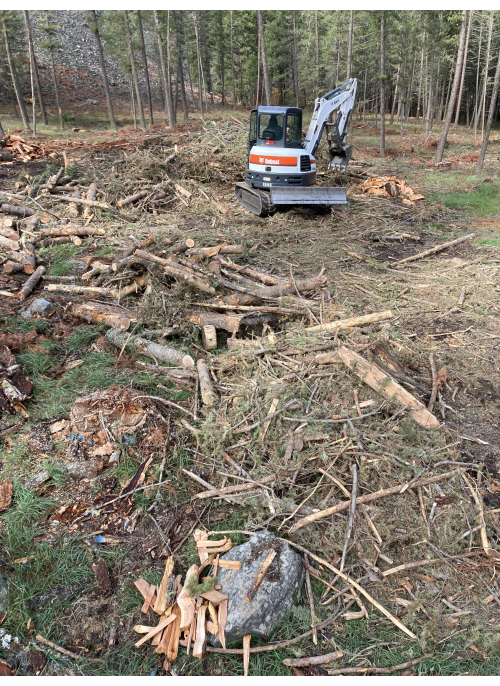
Figure 2: Example of an excavator moving wood residues. Mini-excavators can be used to load the biochar-producing air curtain burner. This figure has been modified from12. Please click here to view a larger version of this figure.
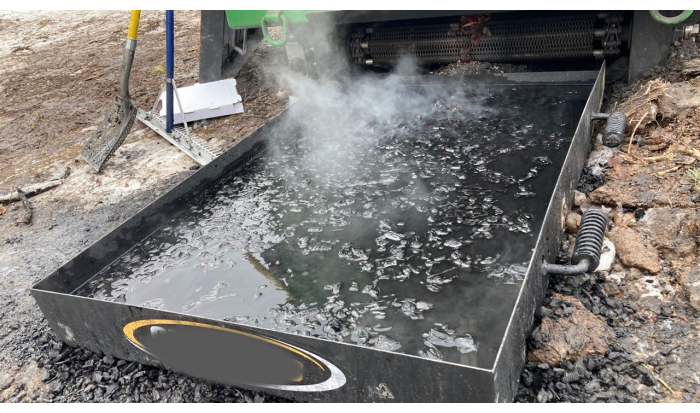
Figure 3: Example of the quench basin placement. The quench basin is kept full of water and positioned approximately 2 inches (5 cm) in front of the conveyor belt. This figure has been modified from12. Please click here to view a larger version of this figure.
3. Hazard reduction
- Before igniting the feedstock, check with the local air quality permitting agency and the local fire department to confirm that the fire danger is not too high for ignition and that air quality monitoring, if required, is in place.
- In addition, before ignition, remove any organic debris from a 6-foot (2 m) area around the BACB to prevent any unintended ignitions. Ensure there is a charged hose connected to an adequate water supply and that the BACB quench pan is filled with water. If possible, keep several 5-gallon (20 L) water buckets ready for dousing unintended ignitions. When burning during elevated fire danger, assess the need to set up sprinklers, a water pump, or a portable water reservoir for extinguishing larger unintended ignitions.
- Ensure that workers can move freely around the sides and back of the machine to access the quench pan, control panel (Figure 4), and the conveyor's manual control point, which is located at the right rear corner of the BACB.
- Ensure workers do not walk in front of the air curtain across from the manifold and wear durable non-synthetic clothing, high visibility vest, hard hat, leather gloves, and eye and hearing protection.
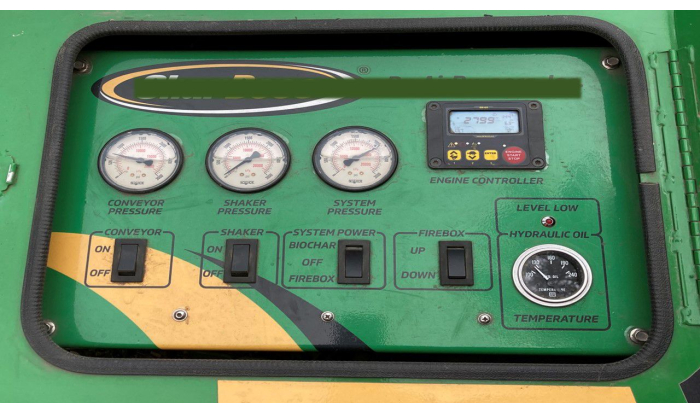
Figure 4: Control panel on the biochar-producing air curtain burner. The control panel is used to turn on the air curtain, conveyor, and system power and to raise and lower the firebox. This figure has been modified from12. Please click here to view a larger version of this figure.
4. Pre-operation checks
- Check all fuel and fluid levels and filters and lubricate the grease points before igniting the feedstock. Once the BACB is operational and at temperature, it may be impossible to inspect, move, or maintain fluid levels, filters, and grease points.
- Check the weather report for the operating location and ensure wind will not exceed ~20 miles per h (30 km per h) during the burn.
- Before ignition, have a conversation with the mini-excavator operator to agree on hand signals (or use a two-way radio) for loading and orientation of wood to ensure a clean burn. Advise the mini-excavator operator to load over the air manifold and not to load the firebox with the feedstock opposite the air manifold.
5. Initial loading and creating a base fire
- Initially load the firebox with dry feedstock (if available) using the mini excavator. Load the wood until the firebox is approximately 2/3rd full, alternating the direction of the materials (i.e., one load should be perpendicular and the next layer parallel to the sides) to create air space that will help the pile burn. Do not pack material into a tight bundle to ensure the material will ignite easily, and do not use the excavator to compact material in the firebox.
- Make sure feedstock is placed throughout the entire firebox to create an even bed of coals. Pay attention to feedstock gaps at the ends of the firebox to ensure even filling and burning.
- Use an ignition aid, such as diesel, on the wood and then light it with a propane torch or other similar ignition device at several points along the firebox.
6. Addition of wood to the firebox
- Allow the base fire to burn until the firebox is approximately half full of burning residues and coals.
- Start the engine and adjust the fan speed for fire conditions. Slowly increase engine speed so the air from the manifold does not blow out the fire. Increase engine speed by pressing the RABBIT button on the control panel (Figure 4).
- Once a good base of coals is achieved, signal the mini-excavator driver to add additional feedstock at a rate that does not smother the fire. Smoke is expected for a short period of time as additional feedstock is added and the air curtain is disrupted. Continuously monitor the BACB and the surrounding area for escaped sparks or embers that can cause unintended ignitions.
7. Biochar production
- When the base fire is established, additional feedstock has been added, and the fan speed has been increased to 2800 rpm, switch the System Power switch to Biochar (Figure 4). Check that the system power is at 1800 psi.
- Switch on the conveyor and shaker. These two functions will cycle automatically every 3 min. Maintain continuous production by toggling the system power switch from Biochar to Firebox (Figure 4). This overrides the intermittent timer mechanism for the shaker and conveyor belt when large amounts of char appear each cycle.
- Collect the biochar in the quench pan and remove biochar from the pan every 5-10 min by using the wide rake to move the biochar to the end of the quench pan and then using the sifting shovel to remove the biochar from the pan and into a pile.
- If the rake gets caught in the conveyor belt, the warning strobe should flash. Toggle the Conveyor switch to OFF at the main control panel, then remove the rake and restart the belt.
- Respond to other warning strobes by checking the pressure gauges on the main control to determine if the shaker panel or the conveyor has stopped. If needed, turn OFF the Shaker to allow the binding wood to burn down or by manually advancing the conveyor belt counterclockwise at the manual control point at the right rear corner of the BACB.
- Refill the quench pans with water, as needed, to allow full dousing of the hot coals. Do not spray water onto the conveyor belt or the ceramic tiles in the firebox.
- Continue adding feedstock into the firebox and creating biochar as long as conditions permit. Make sure larger diameter wood is added earlier in the day so it can be fully converted to char.
8. Ceasing operations
- Stop loading the firebox approximately 1 to 2 h before the end of the shift.
- Turn OFF the shaker when the remaining material no longer contacts the shaker panel and do not leave hot coals in the firebox or on the conveyor belt at the end of the day.
- Leave the conveyor switch ON until all coals have exited the firebox. At this point, it is appropriate to switch to Biochar mode for intermittent cycling.
- During the day ash accumulates under the conveyor belt (Figure 5). Move the BACB each day to a new level location to prevent the ash from impeding conveyor belt movement.
- Once the fire is out and the coals are all quenched, cease the operations for the day.
NOTE: In an emergency, the fire in the firebox can be extinguished by loading soil onto the burning coals. - Leave the sides of the firebox down overnight to insulate the tires from the hot ash under the conveyor belt.
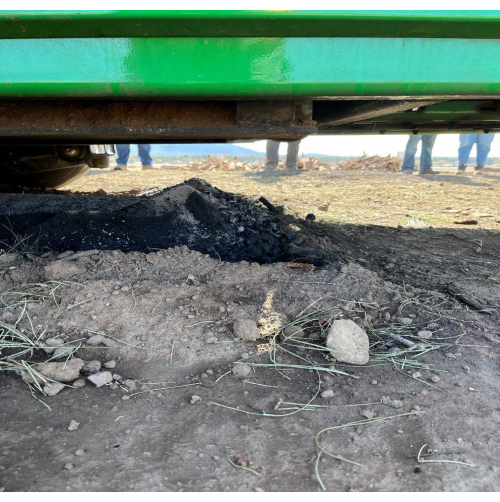
Figure 5: Example of ash and biochar under the conveyor belt. During a burn, some ash and biochar will fall through the metal conveyor belt. This figure has been modified from12. Please click here to view a larger version of this figure.
9. Re-positioning the BACB
- Hitch the BACB to the towing vehicle, raise the sides of the firebox, insert the travel pins, raise the jack stand, and immediately tow the unit straight forward.
- Cool the remaining ash (Figure 6) by mixing it with water and distributing it across the soil. Ensure all coals and ash material are cold to the touch before moving to a new location.
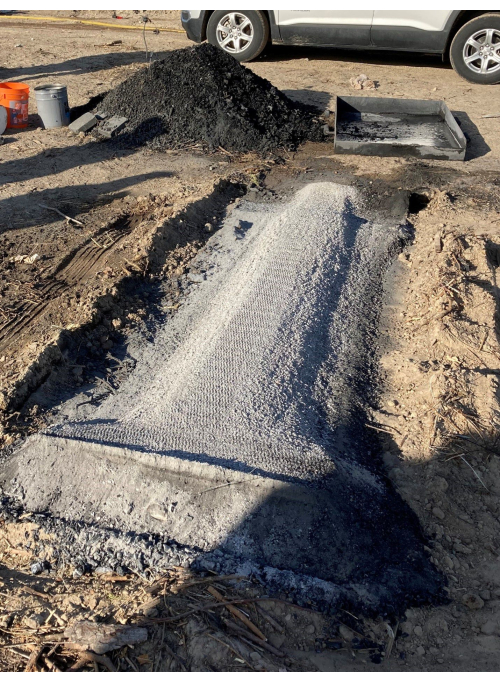
Figure 6: Example of ash buildup. By the end of the day, the ash accumulation under the conveyor belt can reach the conveyor belt. Trenching before placing the biochar-producing air curtain burner is one method to extend the burn time in one location. If trenching is not an option, then the equipment should be pulled forward and ash cleaned out each day. This figure has been modified from12. Please click here to view a larger version of this figure.
Results
From January 2022 through October 2023, the BACB pyrolyzed various feedstocks into biochar (Table 1). Based on field trials, the BACB can burn approximately 1 ton (900 kg) of feedstock per h, and approximately 11%-25% of dry mass of the feedstock will be retained as biochar, with the balance going to gas (water vapor, CO2, etc.) and ash. Carbon content ranges from 70%-90%. Larger pieces of wood (>30 cm) take a longer time to pyrolyze than wood with a diameter ranging from 2-30 cm. The...
Discussion
The first critical step in this method is to ensure the equipment is placed nearly level on both axes so that the firebox side panels block smoke from leaving and air from entering the firebox. Other critical steps are to conduct frequent conversations with the excavator operator to place the feedstock into the firebox where needed and brief all workers on the safety aspects of operating the air burner and excavator. There are a few modifications that can be made with this equipment, but running the conveyor belt and sha...
Disclosures
The authors have nothing to disclose.
Acknowledgements
We thank the numerous University personnel, National Forest, and Bureau of Land Management personnel who helped conduct demonstrations and gather data. The field work for this method was supported by the U.S.D.A. Forest Service Rocky Mountain Research Station, Washington D.C., and Pacific Northwest Region offices. The findings and conclusions in this publication are those of the authors and should not be construed to represent any official U.S.D.A. or U.S. Government determination or policy.
Materials
| Name | Company | Catalog Number | Comments |
| CharBoss air curtain burner | Air Burners, Inc. | T26 | Comes with 36" landscape rake, sifting shovel, 1/2" drive standard ratchet with 1 1/8" socket, grease gun, and quench pan |
| Diesel fuel (Ultra-low sulfur) | Purchased locally | ||
| Diesel fuel tanks | Uline | H-1849Y | or similar |
| Engine oil (diesel grade) | Any diesel grade oil 15W40 or 10W40. | ||
| Excavator | Local rental company. Smaller sizes require less fuel. | ||
| High temperature anti-seize lubricant (16 oz cartridge) | McMaster-Carr | 1288K97 | lubricating hydraulic fittings |
| Hydraulic Oil | Amsoil | HVH05-EA (ISO32) /HVG05-EA (ISO22) | Any ISO32 synthetic hydraulic oil, ISO22 option for cold weather. Amsoil ISO32 is factory installed. |
| Large buckets | Uline | 5495 | or similar |
| Lighting torch (propane) | Grainger | 9RCF3 | or similar |
| 1-ton pickup (or larger) | Rent locally | for transporting CharBoss to site | |
| Viewing step | Gorilla | GLP=WP | Stable step to allow viewing into firebox or other bench-style step |
| Water truck | Any available water truck with minimum 300 gallon capacity; gravity feed of water to the quench pan can be used. | ||
| Wheel chocks | Blocks of 4"x 4" lumber or commercially available chocks while hitching/unhitching unit | ||
| Personal protective equipment | |||
| Ear protection | Uline | S-22141 | or similar |
| Eye protection | Amazon | or similar | |
| Fire shirt | Grainger | 12R487 | or similar |
| Fire pants | Grainger | 39EM96 | or similar |
| Hard hat | Discount Safety Gear | SFTSCHH1000038126 | or similar |
| Leather gloves | Uline | S-6777M | or similar |
| Sturdy boots | any thick soled, leather boot. | ||
| Emergency gear | |||
| Garmin InReach | Cabelas | 100195666 | or similar |
| Pulaski axe | Forestry suppliers | 85274 | or similar |
| Fire rake | Forestry suppliers | 85210 | or similar |
References
- Barrett, S. W., Arno, S. F. Indian fires as an ecological influence in the northern Rockies. J Forestry. 80, 647-651 (1982).
- Savage, M., Swetnam, T. W. Early 19th century fire decline following sheep pasturing in the Navajo ponderosa pine forest. Ecology. 71, 2374-2378 (1990).
- Sohn, J. A., Hartig, F., Kohler, M., Huss, J., Bauhus, J. Heavy and frequent thinning promotes drought adaptation in Pinus sylvestris forests. Eco Appl. 26, 2190-2205 (2016).
- . Air Burners, Inc Available from: https://airburners.com/technology/principle (2024)
- U.S. Department of Energy. 2016 Billion-ton report: Advancing domestic resources for a thriving bioeconomy. U.S. Department of Energy. , (2016).
- Jang, W., Page-Dumroese, D. S., Han, H. S. Comparison of heat transfer and soil impacts of air curtain burner burning and slash pile burning. Forests. 8, 297 (2017).
- Rhoades, C. C., Fegel, T. S., Zaman, T., Fornwalt, P. J., Miller, S. P. Are soil changes responsible for persistent slash pile burn scars in lodgepole pine forests. Forest Eco Management. 490, 119090 (2021).
- Rodriguez Franco, C., Page-Dumroese, D. S., Archuleta, J. Forest management and biochar for continued ecosystem services. J Soil Water Cons. 77, 60-64 (2020).
- Lee, E., Han, H. S. Air Curtain Burners: A tool for disposal of forest residues. Forests. 8, 296 (2017).
- Fornwalt, P. J., Rhoades, C. C. Rehabilitating slash pile burn scars in upper montane forests of the Colorado Front Range. Natural Area J. 31 (2), 177-182 (2011).
- Blanco-Canqui, H. Does biochar improve all soil ecosystem services. GCB-Bioenergy. 13, 291-304 (2020).
- . USDA Forest Service Available from: https://www.fs.usda.gov/ (2024)
- Razzaghi, F., Obour, P. B., Arthur, E. Does biochar improve soil water retention? A systematic review and meta-analysis. Geoderma. 361, 1 (2020).
- U.S. Department of Agriculture, Forest Service, Technology and Development Program. The use of air curtain destructors for fuel reduction. Fire Management Tech Tips #0251 1317-SDTDC. U.S. Department of Agriculture, Forest Service, Technology and Development Program. , 5 (2002).
- Puettmann, M., Sahoo, K., Wilson, K., Oneil, E. Life cycle assessment of biochar produced from forest residues using portable systems. J Cleaner Prod. 250, 119564 (2020).
- Miller, C. A., Lemieux, P. M. Emissions from the burning of vegetative debris in air curtain destructors. Air Waste Management Assoc. 57, 959-967 (2007).
- Rodriguez Franco, C., Page-Dumroese, D. S., Pierson, D., Nicosia, T. Biochar utilization as a forestry climate-smart tool. Sustainability. 16, 1714 (2024).
- Busse, M. D., Shestak, C. J., Hubbert, K. R. Soil heating during burning of forest slash piles and wood piles. Int J Wildland Fire. 22 (6), 786-796 (2013).
Reprints and Permissions
Request permission to reuse the text or figures of this JoVE article
Request PermissionThis article has been published
Video Coming Soon
Copyright © 2025 MyJoVE Corporation. All rights reserved